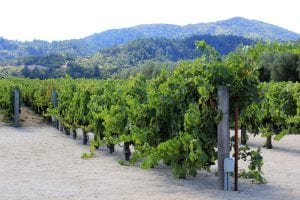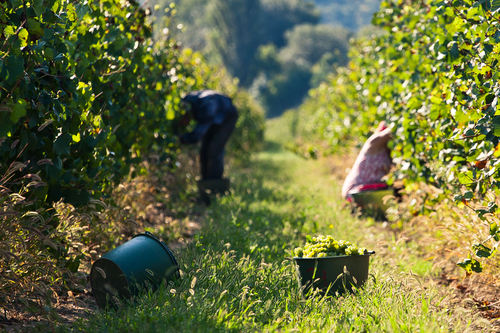The 2017 wine grape harvest is under way in California, putting the industry on track for a more traditional harvest season than the previous few years. Last year growers were harvesting up to two weeks earlier.
 Early varieties such as Pinot Noir began harvest at the end of August. Cabernet Sauvignon, Syrah and other later varieties are expected to stay on the vine until later in September. Due to high temperatures, growers in the Livermore Valley began harvesting Chardonnay earlier than planned. The high temperatures also offset the wet winter California experienced that caused many growers to believe irrigation demands were going to be low.
Early varieties such as Pinot Noir began harvest at the end of August. Cabernet Sauvignon, Syrah and other later varieties are expected to stay on the vine until later in September. Due to high temperatures, growers in the Livermore Valley began harvesting Chardonnay earlier than planned. The high temperatures also offset the wet winter California experienced that caused many growers to believe irrigation demands were going to be low.
Overwatering vineyards can cause problems when approaching harvest time, but many growers were forced to irrigate more than anticipated to keep the canopy healthy enough to combat dehydration. The amount of rainfall seen over winter helped with vine health, but the late rains in spring had a negative impact on fruit set. Hailstorms in early June also caused significant damage in Contra Costa County and areas of Napa.
The rain in later spring was not the only weather concern for growers this year. The heatwave California experienced caused some wineries to pick at night when temperatures were lower and process the grapes in the morning before it got too hot. High temperatures also put added pressure on labor in some areas, with growers struggling to find enough pickers to get the grapes off the vine in a timely manner.
The labor situation in Sonoma County became critical, causing some growers to prepay vineyard management companies and began scheduling two weeks in advance when possible. Costs have also significantly increased, nearly doubling from five years ago. Competition in the Napa and Sonoma regions has resulted in some workers at high-end wineries earning as much as $45 an hour at peak harvest.
Many growers have been switching to machine harvesters to save money on higher wages and limited workdays. Nearly 80 percent of the state’s wine grapes are now being mechanically harvested. Harvester technology has developed to a point that grapes can retain better quality and have the advantage of being delivered quicker.
The wine grape harvest timeline is closer to what is considered customary, however, the overall crop appears to be slightly below normal. Estimates put this year’s crop at a little more than 4 million tons, a decrease of about five percent compared to last year. Tonnage might not be what growers hoped for, but it appears that it will be a good year in terms of quality.
The wet weather during winter and spring allowed more nutrients to get into the roots. The warm weather then slowed down the ripening process allowing the fruit to continue developing, creating higher sugar levels and bolder flavors. Once the heat wave subsided it allowed acid levels to balance out sugar levels.
Many wine grapes are still ripening on the vine in some areas, but the overall wine market in California appears stable with relatively balanced prices. California is the world’s fourth largest producer of wine, with over 110 varieties of wine grapes grown on approximately 560,000 acres that cover 49 counties throughout the state.










